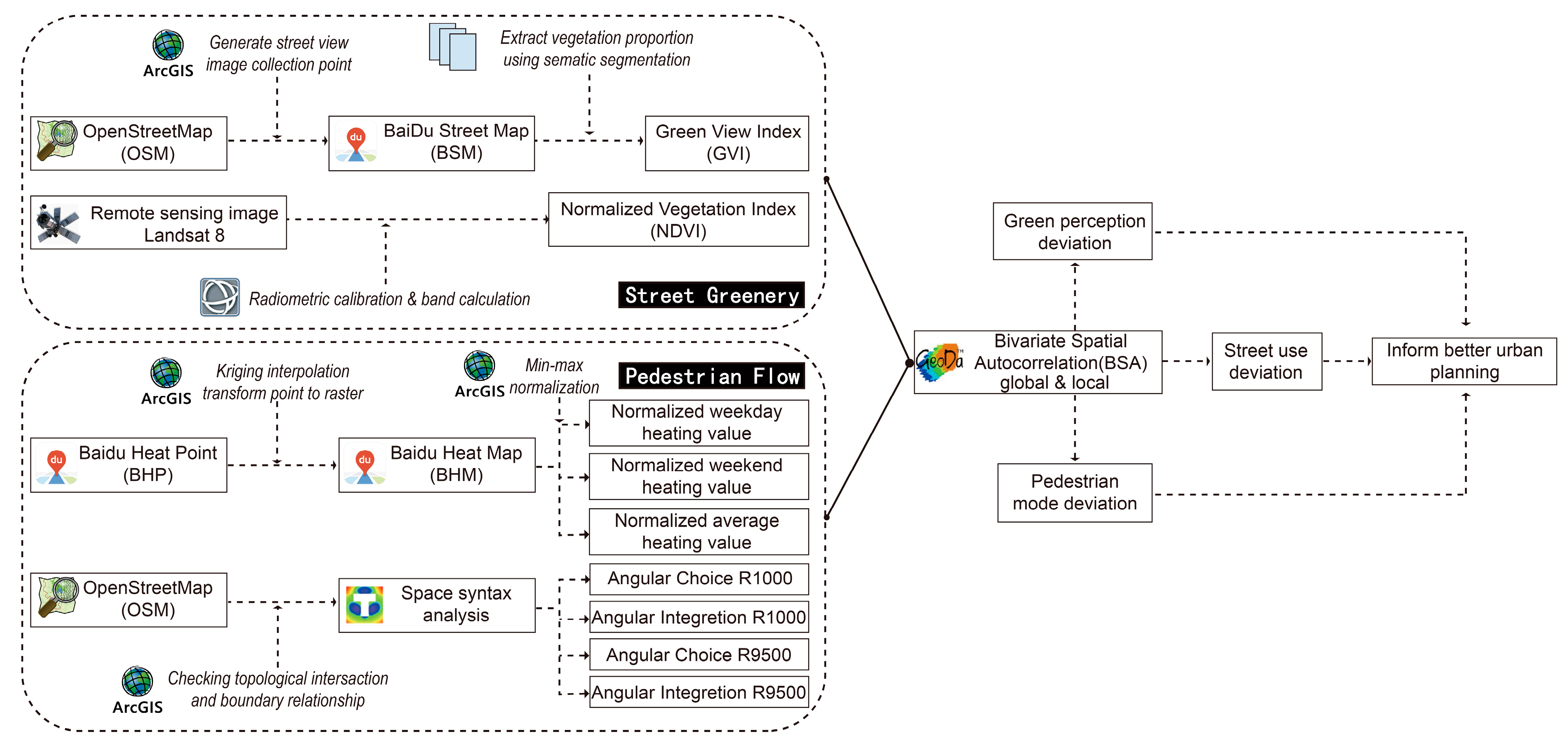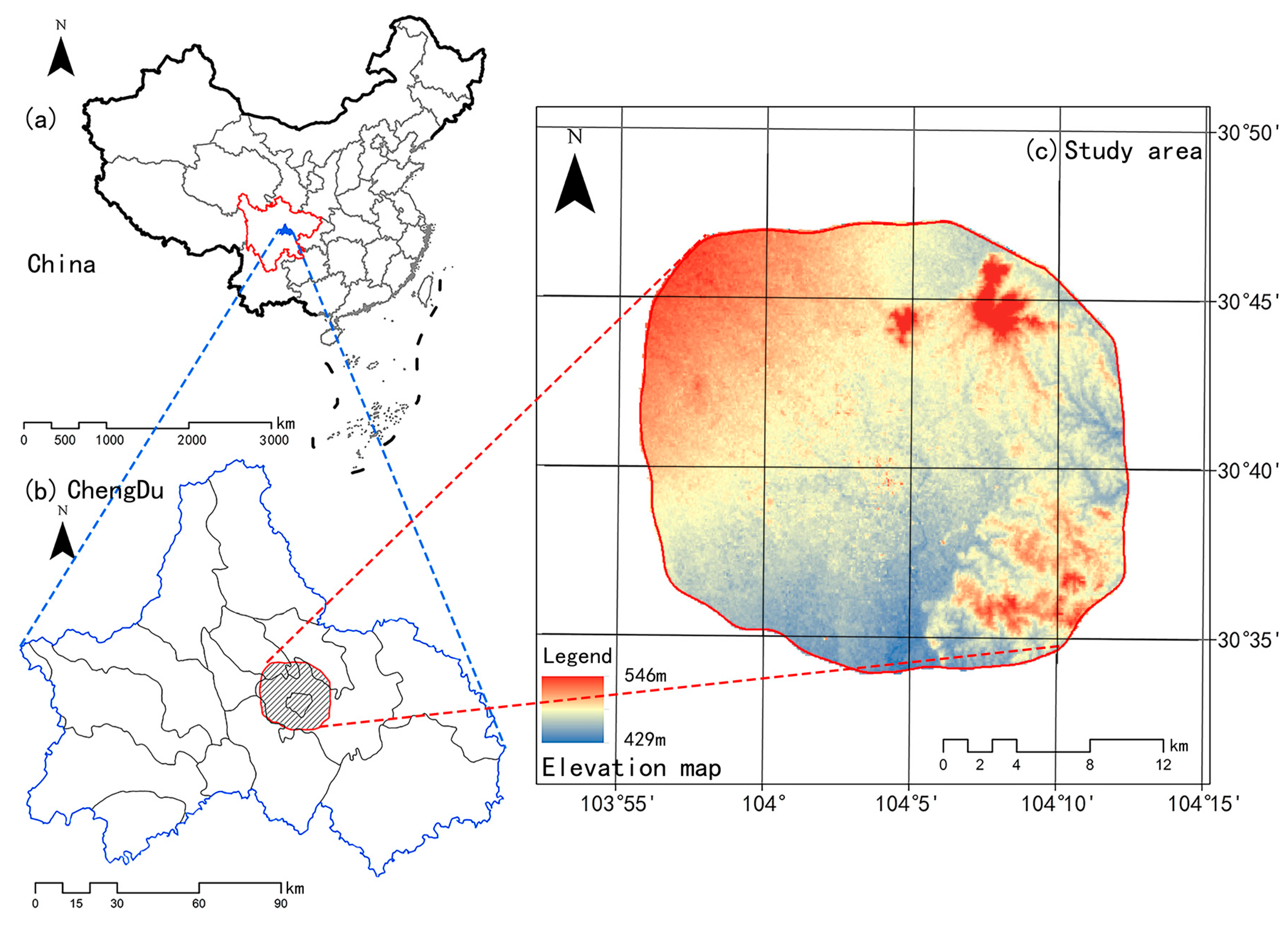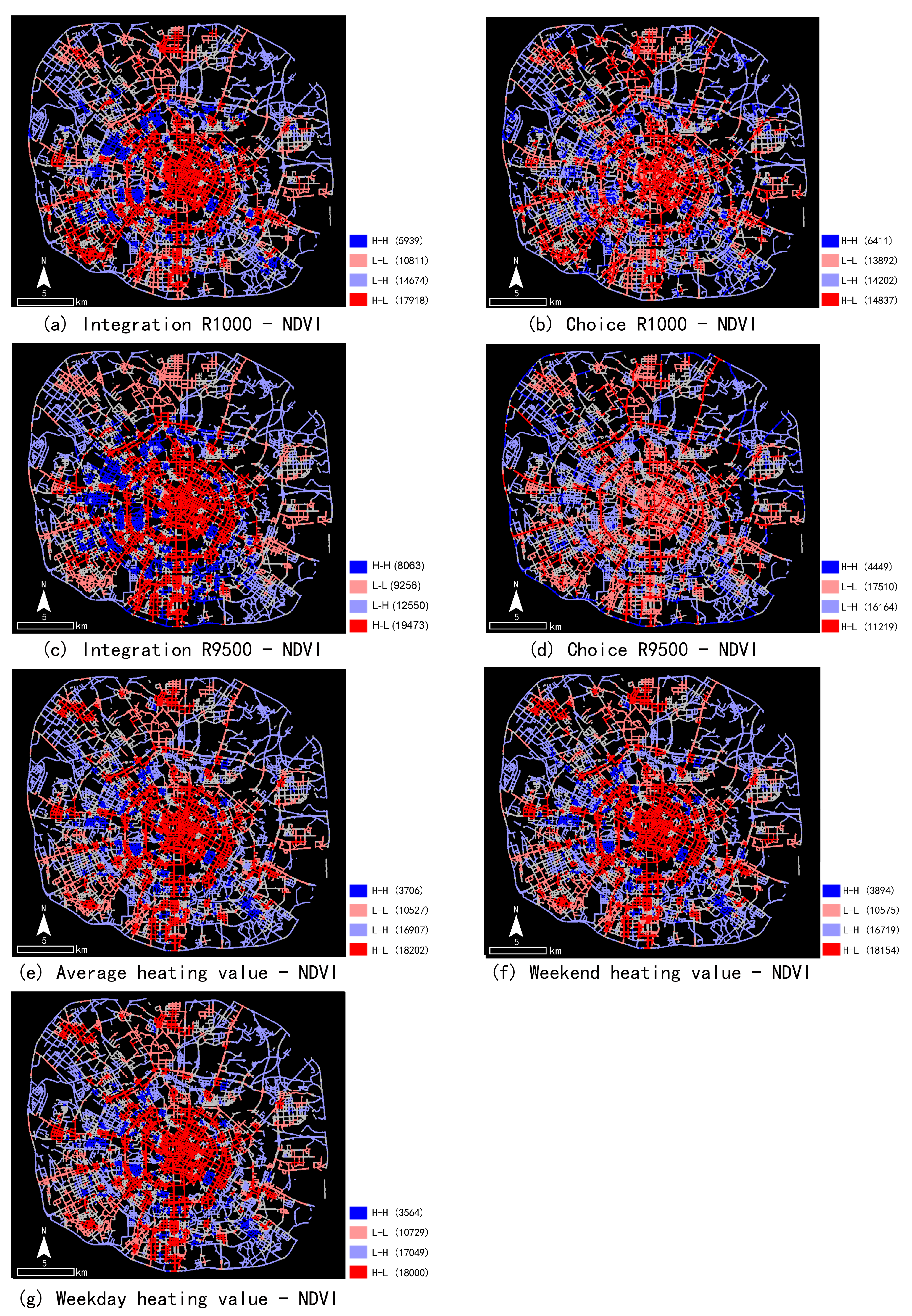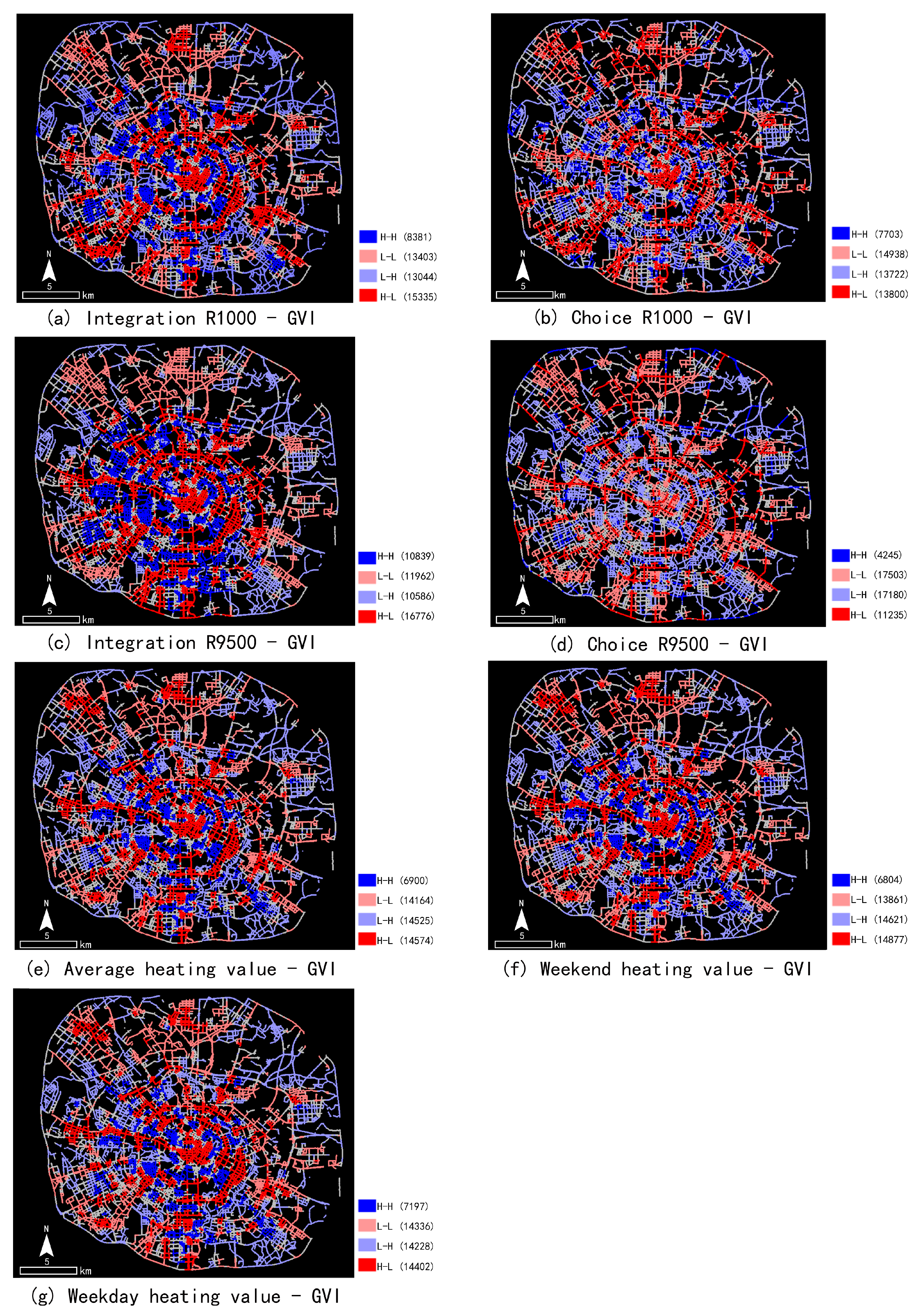Advanced Integration of Urban Street Greenery and Pedestrian Flow: A Multidimensional Analysis in Chengdu’s Central Urban District
Abstract
:1. Introduction
2. Materials and Methods
2.1. Research Area
2.2. Measurement of Street Greenery Indicators
2.3. Measurement of Street Pedestrian Flow Indicators
2.4. Bivariate Spatial Autocorrelation (BSA)
3. Results
3.1. Spatial Heterogeneity of Different Indicators
3.2. Bivariate Global Spatial Distribution Characteristics
3.3. Bivariate Local Spatial Distribution Characteristics
4. Discussion
4.1. Flow Perspective in Urban Design
4.2. Temporal Mismatch in Urban Greenery
4.3. Guidance for Precise Urban Renewal
5. Conclusions
Author Contributions
Funding
Data Availability Statement
Acknowledgments
Conflicts of Interest
References
- Wang, J.; Hu, Y.; Duolihong, W. Diagnosis and Planning Strategies for Quality of Urban Street Space Based on Street View Images. ISPRS Int. J. Geo-Inf. 2023, 12, 15. [Google Scholar] [CrossRef]
- Hasan, A.N.; Al-Khafaji, D.S.J. Integration of Intermodal Transport Stations as a Tool for Urban Renewal in the City of Baghdad. IOP Conf. Ser. Mater. Sci. Eng. 2021, 1067, 012030. [Google Scholar] [CrossRef]
- Ma, X.; Ma, C.; Wu, C.; Xi, Y.; Yang, R.; Peng, N.; Zhang, C.; Ren, F. Measuring human perceptions of streetscapes to better inform urban renewal: A perspective of scene semantic parsing. Cities 2021, 110, 103086. [Google Scholar] [CrossRef]
- Xia, Y.; Yabuki, N.; Fukuda, T. Development of a system for assessing the quality of urban street-level greenery using street view images and deep learning. Urban For. Urban Green. 2021, 59, 126995. [Google Scholar] [CrossRef]
- Wang, R.; Helbich, M.; Yao, Y.; Zhang, J.; Liu, P.; Yuan, Y.; Liu, Y. Urban greenery and mental wellbeing in adults: Cross-sectional mediation analyses on multiple pathways across different greenery measures. Environ. Res. 2019, 176, 108535. [Google Scholar] [CrossRef]
- Bain, L.; Gray, B.; Rodgers, D. Living Streets: Strategies for Crafting Public Space; Wiley: New York, NY, USA, 2012. [Google Scholar]
- Ananyeva, O.; Emmanuel, R. Street trees and Urban Heat Island in Glasgow: Mitigation through the ‘Avenues Programme’. Urban For. Urban Green 2023, 86, 128041. [Google Scholar] [CrossRef]
- Zhang, J.; Hu, A. Analyzing green view index and green view index best path using Google street view and deep learning. J. Comput. Des. Eng. 2022, 9, 2010–2023. [Google Scholar] [CrossRef]
- Tang, L.; He, M.; Li, X. Verification of Fractional Vegetation Coverage and NDVI of Desert Vegetation via UAVRS Technology. Remote Sens. 2020, 12, 1742. [Google Scholar] [CrossRef]
- Zhu, H.; Nan, X.; Yang, F.; Bao, Z. Utilizing the green view index to improve the urban street greenery index system: A statistical study using road patterns and vegetation structures as entry points. Landsc. Urban Plan. 2023, 237, 104780. [Google Scholar] [CrossRef]
- Meng, Y.; Xing, H.; Yuan, Y.; Wong, M.S.; Fan, K. Sensing urban poverty: From the perspective of human perception-based greenery and open-space landscapes. Comput. Environ. Urban Syst. 2020, 84, 101544. [Google Scholar] [CrossRef]
- Li, T.; Xu, H.; Sun, H. Spatial Patterns and Multi-Dimensional Impact Analysis of Urban Street Quality Perception under Multi-Source Data: A Case Study of Wuchang District in Wuhan, China. Appl. Sci. 2023, 13, 11740. [Google Scholar] [CrossRef]
- Helbich, M.; Yao, Y.; Liu, Y.; Zhang, J.; Liu, P.; Wang, R. Using deep learning to examine street view green and blue spaces and their associations with geriatric depression in Beijing, China. Environ. Int. 2019, 126, 107–117. [Google Scholar] [CrossRef] [PubMed]
- Yang, L.; Liu, J.; Liang, Y.; Lu, Y.; Yang, H. Spatially Varying Effects of Street Greenery on Walking Time of Older Adults. ISPRS Int. J. Geo-Inf. 2021, 10, 596. [Google Scholar] [CrossRef]
- Ye, Y.; Richards, D.; Lu, Y.; Song, X.; Zhuang, Y.; Zeng, W.; Zhong, T. Measuring daily accessed street greenery: A human-scale approach for informing better urban planning practices. Landsc. Urban Plan 2019, 191, 103434. [Google Scholar] [CrossRef]
- Yamu, C.; van Nes, A.; Garau, C. Bill Hillier’s Legacy: Space Syntax—A Synopsis of Basic Concepts, Measures, and Empirical Application. Sustainability 2021, 13, 3394. [Google Scholar] [CrossRef]
- Hillier, B.; Iida, S. Network and Psychological Effects in Urban Movement. In Proceedings of the Spatial Information Theory; Cohn, A.G., Mark, D.M., Eds.; Springer: Berlin/Heidelberg, Germany, 2005; pp. 475–490. [Google Scholar]
- Zhou, Q.; Zheng, Y. Research on the spatial layout optimization strategy of Huaihe Road Commercial Block in Hefei city based on space syntax theory. Front. Comput. Neurosci. 2023, 16, 1084279. [Google Scholar] [CrossRef] [PubMed]
- Yoo, C.; Lee, S. When Organic Urban Forms and Grid Systems Collide: Application of Space Syntax for Analyzing the Spatial Configuration of Barcelona, Spain. J. Asian Arch. Build. Eng. 2017, 16, 597–604. [Google Scholar] [CrossRef]
- Atakara, C.; Allahmoradi, M. Investigating the Urban Spatial Growth by Using Space Syntax and GIS—A Case Study of Famagusta City. ISPRS Int. J. Geo-Inf. 2021, 10, 638. [Google Scholar] [CrossRef]
- Zhang, J.; Hu, J.; Zhang, X.; Li, Y.; Huang, J. Towards a Fairer Green city: Measuring unfairness in daily accessible greenery in Chengdu’s central city. J. Asian Archit. Build. Eng. 2023, 1–20. [Google Scholar] [CrossRef]
- Huang, B.-X.; Chiou, S.-C.; Li, W.-Y. Accessibility and Street Network Characteristics of Urban Public Facility Spaces: Equity Research on Parks in Fuzhou City Based on GIS and Space Syntax Model. Sustainability 2020, 12, 3618. [Google Scholar] [CrossRef]
- Wang, L.; Han, X.; He, J.; Jung, T. Measuring residents’ perceptions of city streets to inform better street planning through deep learning and space syntax. ISPRS J. Photogramm. Remote Sens. 2022, 190, 215–230. [Google Scholar] [CrossRef]
- Tsai, M.-T.; Chang, H.-W. Contribution of Accessibility to Urban Resilience and Evacuation Planning Using Spatial Analysis. Int. J. Environ. Res. Public Health 2023, 20, 2913. [Google Scholar] [CrossRef] [PubMed]
- Zhang, F.; Ye, X. What Can We Learn from “Deviations” in Urban Science? In New Thinking in GIScience; Li, B., Shi, X., Zhu, A.-X., Wang, C., Lin, H., Eds.; Springer: Singapore, 2022; pp. 301–308. ISBN 978-981-19381-5-3. [Google Scholar]
- Kizilhan, T.; Kizilhan, S.B. The Rise of the Network Society-The Information Age: Economy, Society, and Culture. Contemp. Educ. Technol. 2016, 7, 277–280. [Google Scholar] [CrossRef] [PubMed]
- Dong, Q.; Cai, J.; Chen, S.; He, P.; Chen, X. Spatiotemporal Analysis of Urban Green Spatial Vitality and the Corresponding Influencing Factors: A Case Study of Chengdu, China. Land 2022, 11, 1820. [Google Scholar] [CrossRef]
- Zhang, S.; Zhang, W.; Wang, Y.; Zhao, X.; Song, P.; Tian, G.; Mayer, A.L. Comparing Human Activity Density and Green Space Supply Using the Baidu Heat Map in Zhengzhou, China. Sustainability 2020, 12, 7075. [Google Scholar] [CrossRef]
- Liu, Y.; Yang, D.; Timmermans, H.J.P.; de Vries, B. Simulating the effects of redesigned street-scale built environments on access/egress pedestrian flows to metro stations. Comput. Urban Sci. 2021, 1, 1–14. [Google Scholar] [CrossRef]
- Zhou, M.; Zhou, J. Structural change and spatial pattern of intentional travel groups: A case study of metro riders in Hong Kong. Appl. Geogr. 2023, 152, 102885. [Google Scholar] [CrossRef] [PubMed]
- Chen, L.; Huang, H.; Yao, D.; Yang, H.; Xu, S.; Liu, S. Construction of Urban Environmental Performance Evaluation System Based on Multivariate System Theory and Comparative Analysis: A Case Study of Chengdu-Chongqing Twin Cities, China. Int. J. Environ. Res. Public Health 2023, 20, 4515. [Google Scholar] [CrossRef] [PubMed]
- Li, Y.; Yabuki, N.; Fukuda, T. Exploring the association between street built environment and street vitality using deep learning methods. Sustain. Cities Soc. 2022, 79, 103656. [Google Scholar] [CrossRef]
- Labib, S.M.; Harris, A. The potentials of Sentinel-2 and LandSat-8 data in green infrastructure extraction, using object based image analysis (OBIA) method. Eur. J. Remote Sens. 2018, 51, 231–240. [Google Scholar] [CrossRef]
- Li, M.; Pan, J. Assessment of Influence Mechanisms of Built Environment on Street Vitality Using Multisource Spatial Data: A Case Study in Qingdao, China. Sustainability 2023, 15, 1518. [Google Scholar] [CrossRef]
- Sharmin, S.; Kamruzzaman, M. Meta-analysis of the relationships between space syntax measures and pedestrian movement. Transp. Rev. 2018, 38, 524–550. [Google Scholar] [CrossRef]
- Yang, C.; Qian, Z. Street network or functional attractors? Capturing pedestrian movement patterns and urban form with the integration of space syntax and MCDA. Urban Des. Int. 2023, 28, 3–18. [Google Scholar] [CrossRef]
- Anselin, L.; Syabri, I.; Smirno, O. Visualizing multivariate spatial correlation with dynamically linked Windows. In Proceedings of the CSISS Workshop on New Tools for Spatial Data Analysis, Santa Barbara, CA, USA, 10–11 May 2002. [Google Scholar]
- Teixeira De Oliveira, J.; Alves De Oliveira, R.; Milena Rojas Plazas, G.; Moreira Andrade, S.; França Da Cunha, F. Distribution and spatial autocorrelation of physical-water attributes of an Oxisol. Rev. Bras. Eng. Biossistemas 2023, 17, 1109. [Google Scholar] [CrossRef]
- Chen, Y.; Yue, W.; La Rosa, D. Which communities have better accessibility to green space? An investigation into environmental inequality using big data. Landsc. Urban Plan. 2020, 204, 103919. [Google Scholar] [CrossRef]
- Dong, L. Research on Quality Improvement and Reconstruction of Mixed-Function Urban Villages Based on Green View Index and Space Syntax. Sustain. Dev. 2021, 11, 531–539. [Google Scholar] [CrossRef]
- Gao, F.; Li, S.; Tan, Z.; Zhang, X.; Lai, Z.; Tan, Z. How Is Urban Greenness Spatially Associated with Dockless Bike Sharing Usage on Weekdays, Weekends, and Holidays? ISPRS Int. J. Geo-Inf. 2021, 10, 238. [Google Scholar] [CrossRef]
- Almanza, E.; Jerrett, M.; Dunton, G.; Seto, E.; Pentz, M.A. A study of community design, greenness, and physical activity in children using satellite, GPS and accelerometer data. Health Place 2012, 18, 46–54. [Google Scholar] [CrossRef] [PubMed]
- Tang, Z.; Ye, Y.; Jiang, Z.; Fu, C.; Huang, R.; Yao, D. A data-informed analytical approach to human-scale greenway planning: Integrating multi-sourced urban data with machine learning algorithms. Urban For. Urban Green 2020, 56, 126871. [Google Scholar] [CrossRef]
- Zhang, J.; Yu, Z.; Li, Y.; Wang, X. Uncovering Bias in Objective Mapping and Subjective Perception of Urban Building Functionality: A Machine Learning Approach to Urban Spatial Perception. Land 2023, 12, 1322. [Google Scholar] [CrossRef]
- Li, Y.; Yabuki, N.; Fukuda, T.; Zhang, J. A big data evaluation of urban street walkability using deep learning and environmental sensors-a case study around Osaka University Suita campus. In Proceedings of the 38th eCAADe Conference: Anthropologic: Architecture and Fabrication in the Cognitive Age, Berlin, Germany, 16–17 September 2020. [Google Scholar]
- Zhang, F.; Zu, J.; Hu, M.; Zhu, D.; Kang, Y.; Gao, S.; Zhang, Y.; Huang, Z. Uncovering inconspicuous places using social media check-ins and street view images. Comput. Environ. Urban Syst. 2020, 81, 101478. [Google Scholar] [CrossRef]
- Zhou, X.; Lang, W.; Yeh, A.G.; Niu, X. Understanding the compactness of employment activities in high-density cities through cellphone location data. Environ. Plan. B Urban Anal. City Sci. 2021, 48, 1398–1413. [Google Scholar] [CrossRef]
- Ren, Q.; Ni, J.; Li, H.; Mao, G.; Hsu, W.-L.; Yang, J. Analysis on Spatial Characteristics of Supply–Demand Relationship of Amenities in Expanding Central Urban Areas—A Case Study of Huai’an, China. Land 2022, 11, 1137. [Google Scholar] [CrossRef]
- Xiao, C.; Shi, Q.; Gu, C.-J. Assessing the Spatial Distribution Pattern of Street Greenery and Its Relationship with Socioeconomic Status and the Built Environment in Shanghai, China. Land 2021, 10, 871. [Google Scholar] [CrossRef]






| Category | Indicator | Data Source | Description and Method |
|---|---|---|---|
| Research preparation data | Road network data | OpenStreetMap (OSM) | Linear data for road network; pre-processing |
| Area of Interest (AOI) | Baidu map | Polygons of different functional areas; pre-processing | |
| Street greenery indicator | Green View Index (GVI) | Baidu street map | Street view images at 69,649 sampling points; semantic segmentation |
| Normalized Difference Vegetation Index (NDVI) | Geospatial data cloud platform | Satellite remote sensing images (Landsat8); NDVI calculation | |
| Street pedestrian flow Indicator | Heatmap value | Baidu Huiyan population location data | Hourly heatmaps for 23, 26 August 2023; Kriging interpolation |
| Integration index | Space syntax analysis | Centrality within the street network; calculated for 1000 m and 9500 m radii | |
| Choice index | Space syntax analysis | Likelihood of pedestrian movement through a segment; calculated for 1000 m and 9500 m radii |
| Variable | BGMI | p-Value |
|---|---|---|
| GVI vs. Integration R1000 | −0.112 | 0.001 * |
| GVI vs. Choice R1000 | −0.073 | 0.001 * |
| GVI vs. Integration R9500 | −0.093 | 0.001* |
| GVI vs. Choice R9500 | −0.098 | 0.001 * |
| GVI vs. Average heatmap | −0.145 | 0.001 * |
| GVI vs. Weekday heatmap | −0.140 | 0.001 * |
| GVI vs. Weekend heatmap | −0.146 | 0.001 * |
| NDVI vs. Integration R1000 | −0.210 | 0.001 * |
| NDVI vs. Choice R1000 | −0.127 | 0.001 * |
| NDVI vs. Integration R9500 | −0.183 | 0.001 * |
| NDVI vs. Choice R9500 | −0.097 | 0.001 * |
| NDVI vs. Average heatmap | −0.238 | 0.001 * |
| NDVI vs. Weekday heatmap | −0.244 | 0.001 * |
| NDVI vs. Weekend heatmap | −0.226 | 0.001 * |
| Area | Average NDVI | Variance NDVI | Max NDVI | Min NDVI | Average GVI | Variance GVI | Max GVI | Min GVI |
|---|---|---|---|---|---|---|---|---|
| City center | 0.02 | 0.02 | 0.62 | −0.51 | 0.22 | 0.02 | 0.71 | 0.01 |
| City periphery | 0.11 | 0.03 | 0.68 | −0.47 | 0.23 | 0.02 | 0.91 | 0.01 |
| Residential areas | 0.08 | 0.03 | 0.68 | −0.51 | 0.21 | 0.02 | 0.92 | 0.01 |
| Commercial areas | 0.04 | 0.03 | 0.67 | −0.51 | 0.20 | 0.02 | 0.92 | 0.01 |
Disclaimer/Publisher’s Note: The statements, opinions and data contained in all publications are solely those of the individual author(s) and contributor(s) and not of MDPI and/or the editor(s). MDPI and/or the editor(s) disclaim responsibility for any injury to people or property resulting from any ideas, methods, instructions or products referred to in the content. |
© 2024 by the authors. Licensee MDPI, Basel, Switzerland. This article is an open access article distributed under the terms and conditions of the Creative Commons Attribution (CC BY) license (https://creativecommons.org/licenses/by/4.0/).
Share and Cite
Ma, Q.; Zhang, J.; Li, Y. Advanced Integration of Urban Street Greenery and Pedestrian Flow: A Multidimensional Analysis in Chengdu’s Central Urban District. ISPRS Int. J. Geo-Inf. 2024, 13, 254. https://doi.org/10.3390/ijgi13070254
Ma Q, Zhang J, Li Y. Advanced Integration of Urban Street Greenery and Pedestrian Flow: A Multidimensional Analysis in Chengdu’s Central Urban District. ISPRS International Journal of Geo-Information. 2024; 13(7):254. https://doi.org/10.3390/ijgi13070254
Chicago/Turabian StyleMa, Qicheng, Jiaxin Zhang, and Yunqin Li. 2024. "Advanced Integration of Urban Street Greenery and Pedestrian Flow: A Multidimensional Analysis in Chengdu’s Central Urban District" ISPRS International Journal of Geo-Information 13, no. 7: 254. https://doi.org/10.3390/ijgi13070254







